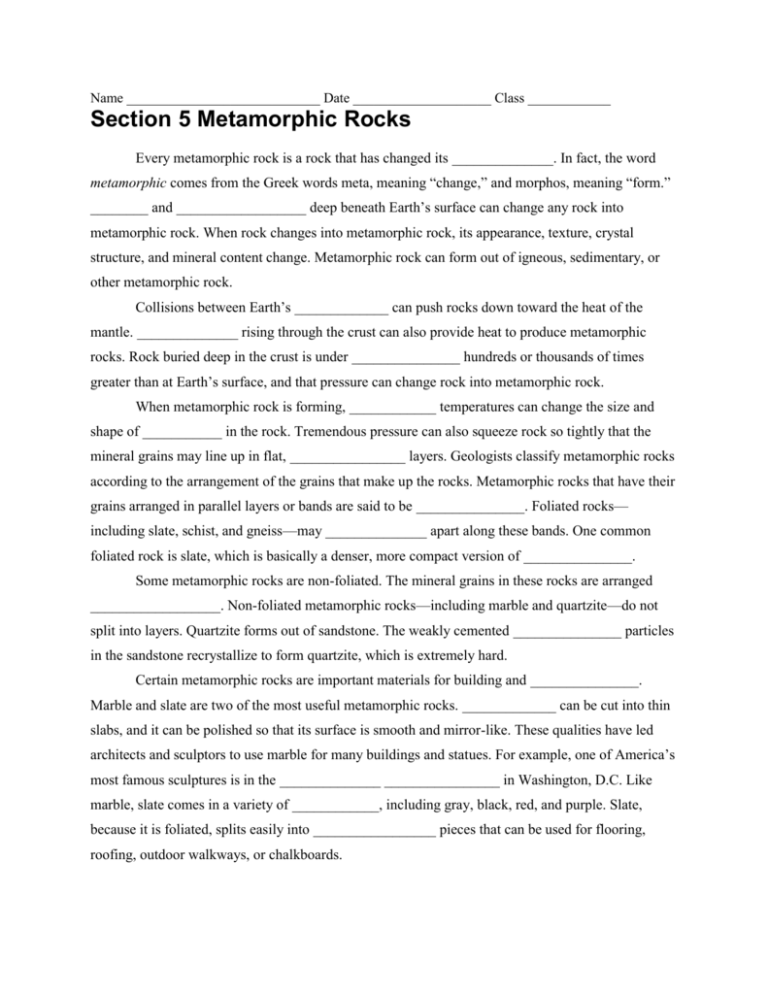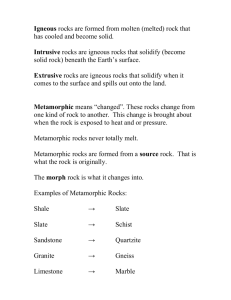Chapter 5 Section 5 and 6 CLOZE
advertisement

Name ____________________________ Date ____________________ Class ____________ Section 5 Metamorphic Rocks Every metamorphic rock is a rock that has changed its ______________. In fact, the word metamorphic comes from the Greek words meta, meaning “change,” and morphos, meaning “form.” ________ and __________________ deep beneath Earth’s surface can change any rock into metamorphic rock. When rock changes into metamorphic rock, its appearance, texture, crystal structure, and mineral content change. Metamorphic rock can form out of igneous, sedimentary, or other metamorphic rock. Collisions between Earth’s _____________ can push rocks down toward the heat of the mantle. ______________ rising through the crust can also provide heat to produce metamorphic rocks. Rock buried deep in the crust is under _______________ hundreds or thousands of times greater than at Earth’s surface, and that pressure can change rock into metamorphic rock. When metamorphic rock is forming, ____________ temperatures can change the size and shape of ___________ in the rock. Tremendous pressure can also squeeze rock so tightly that the mineral grains may line up in flat, ________________ layers. Geologists classify metamorphic rocks according to the arrangement of the grains that make up the rocks. Metamorphic rocks that have their grains arranged in parallel layers or bands are said to be _______________. Foliated rocks— including slate, schist, and gneiss—may ______________ apart along these bands. One common foliated rock is slate, which is basically a denser, more compact version of _______________. Some metamorphic rocks are non-foliated. The mineral grains in these rocks are arranged __________________. Non-foliated metamorphic rocks—including marble and quartzite—do not split into layers. Quartzite forms out of sandstone. The weakly cemented _______________ particles in the sandstone recrystallize to form quartzite, which is extremely hard. Certain metamorphic rocks are important materials for building and _______________. Marble and slate are two of the most useful metamorphic rocks. _____________ can be cut into thin slabs, and it can be polished so that its surface is smooth and mirror-like. These qualities have led architects and sculptors to use marble for many buildings and statues. For example, one of America’s most famous sculptures is in the ______________ ________________ in Washington, D.C. Like marble, slate comes in a variety of ____________, including gray, black, red, and purple. Slate, because it is foliated, splits easily into _________________ pieces that can be used for flooring, roofing, outdoor walkways, or chalkboards. Name ____________________________ Date ____________________ Class ____________ Section 6 The Rock Cycle Earth’s rocks are not as ____________________ as they seem. Forces deep inside Earth and at the surface produce a slow cycle that builds, ___________, and ____________ the rocks in the crust. The rock cycle is a series of processes on Earth’s surface and in the crust and mantle that slowly change rocks from one kind to another. One possible pathway through the rock cycle began with the formation of the igneous rock granite beneath the surface. The forces of mountain building slowly pushed the granite upward, forming a _______________. Slowly, water and __________ wore away the granite. The resulting sand was carried by streams to the ocean. Over millions of years, layers of ______________ piled up on the ocean floor and changed to sandstone, a _________________ rock. Over time, the sandstone became deeply buried. Heat and ______________ changed the sandstone to the metamorphic rock quartzite. The changes of the rock cycle are closely related to __________ _____________. Plate movements start the rock cycle by helping to form ___________, the source of igneous rocks. Plate movements also cause faulting, folding, and other motions of the crust that help to form sedimentary and metamorphic rocks. Where oceanic plates move ______________, magma formed from melted mantle rock moves upward and fills the gap with new igneous rock. A _________________ of continental plates may push rocks so deep that they melt and form magma. This magma slowly cools and hardens to form __________________ rock. Sedimentary rock is formed when mountains are worn away by __________________. The mountains were formed by the collision of continental plates that produced faults, folds, and uplift of the crust. Metamorphic rock forms from ________________ and pressure on rocks pushed down deep in the mantle by a collision between continental plates.








